

Russia vs Ukraine: Crimea’s Water Crisis Is an Impossible Problem for Putin. Photographer: STR/AFP via Getty Images A water emergency in Crimea is absorbing billions of taxpayer rubles as Russia tries to patch up an impossible problem stemming from the peninsula’s annexation in 2014.

President Vladimir Putin’s Black Sea gem looks increasingly like a millstone. Ukraine dammed the North Crimean Canal seven years ago, cutting off the source of nearly 90% of the region’s fresh water and setting it back to the pre-1960s, when much was arid steppe. Add a severe drought and sizzling temperatures last year, plus years of underinvestment in pipes and drilling, and fields are dry.
In the capital Simferopol and elsewhere, water has been rationed. Tiny Crimea gave Putin a boost, when, following protests that overthrew Kyiv’s Russia-friendly government, he seized a territory that belonged to Moscow for centuries but had been part of an independent Ukraine since 1991. The need to pour even more cash into Crimea means Russians elsewhere may lose out.
Crimea That’s a challenge. Economist Intelligence Unit. As the world’s philanthropists boost climate funding, let’s make water a priority - BCFN Foundation: Food and Nutrition Sustainability Index. Claudia Sadoff, Director General of the International Water Management Institute (IWMI) Claudia Sadoff, director general of the International Water Management Institute, argues that our efforts to mitigate the impacts of climate change and address food security could be counterproductive if we don’t pay more attention to water and its use.

Few details were revealed about Amazon chief Jeff Bezos’ new US$10bn Bezos Earth Fund to tackle climate change, but the announcement last month was clear about one thing: science-backed, evidence-based solutions are critical in this fight. There are already many “known ways” to address the climate emergency, but what these solutions often miss at their core is the vital importance of water. Most of us worldwide will experience climate change through the impact of unpredictable rainfall, retreating glaciers and melting snowpacks. Barking up the wrong tree? Economist Intelligence Unit. This harvester can pull record amounts of water out of thin air. Today we bring you a story from Johns Hopkins University where scientists have discovered materials that can collect huge amounts of water from the surrounding air.
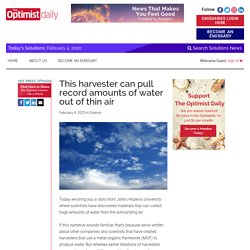
If this narrative sounds familiar, that’s because we’ve written about other companies and scientists that have created harvesters that use a metal-organic framework (MOF) to produce water. But whereas earlier iterations of harvesters manage to produce a little over a liter of water per day per kilogram of MOF, the Johns Hopkins harvester easily surpasses this threshold, producing 8.66 liters (2.3 gallons) of water per day per kilogram of MOF. To create this better-performing new version, the team studied 10 different types of MOFs, examining which properties made them more effective. A Quarter of Humanity Faces Looming Water Crises. BANGALORE, India — Countries that are home to one-fourth of Earth’s population face an increasingly urgent risk: The prospect of running out of water.

From India to Iran to Botswana, 17 countries around the world are currently under extremely high water stress, meaning they are using almost all the water they have, according to new World Resources Institute data published Tuesday. Many are arid countries to begin with; some are squandering what water they have. Several are relying too heavily on groundwater, which instead they should be replenishing and saving for times of drought. In those countries are several big, thirsty cities that have faced acute shortages recently, including São Paulo, Brazil; Chennai, India; and Cape Town, which in 2018 narrowly beat what it called Day Zero — the day when all its dams would be dry. Chennai water crisis: City's reservoirs run dry. The Water Abundance XPrize winner makes water from air. A new device that sits inside a shipping container can use clean energy to almost instantly bring clean drinking water anywhere–the rooftop of an apartment building in Nairobi, a disaster zone after a hurricane in Manila, a rural village in Zimbabwe–by pulling water from the air.
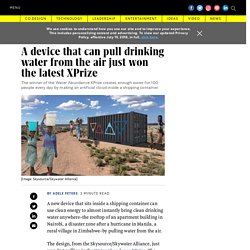
The design, from the Skysource/Skywater Alliance, just won $1.5 million in the Water Abundance XPrize. The competition, which launched in 2016, asked designers to build a device that could extract at least 2,000 liters of water a day from the atmosphere (enough for the daily needs of around 100 people), use clean energy, and cost no more than 2¢ a liter. “We do a lot of first principles thinking at XPrize when we start designing these challenges,” says Zenia Tata, who helped launch the prize and serves as chief impact officer of XPrize.
Nearly 800 million people face water scarcity; other solutions, like desalination, are expensive. Freshwater is limited and exists in a closed system. Cheap, simple technique turns seawater into drinking water Researchers from the University of Alexandria have developed a cheaper, simpler and potentially cleaner way to turn seawater into drinking water than conventional methods.
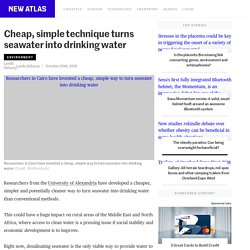
This could have a huge impact on rural areas of the Middle East and North Africa, where access to clean water is a pressing issue if social stability and economic development is to improve. Right now, desalinating seawater is the only viable way to provide water to growing populations, and large desalination plants are now a fact of life in Egypt and other Middle Eastern countries. Most of these plants rely on a multi-step process based on reverse osmosis, which requires expensive infrastructure and large amounts of electricity.
These plants release large quantities of highly concentrated salt water and other pollutants back into the seas and oceans as part of the desalination process, creating problems for marine environments. The technology uses a method of separating liquids and solids called pervaporation. The Nomad Pavilion is a woven goat hair desert shelter that collects its own water. Architects Dina Haddadin and Rasem Kamal have teamed up to create the Nomad Pavilion, an innovative structure that serves as both a desert shelter and a water tower.
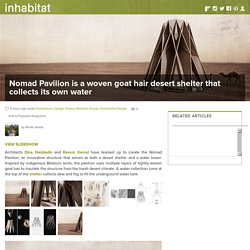
Inspired by indigenous Bedouin tents, the pavilion uses multiple layers of tightly-woven goat hair to insulate the structure from the harsh desert climate. A water collection cone at the top of the shelter collects dew and fog to fill the underground water tank. The hybrid shelter and water tower is made from 96 Corten steel rods and knotted ropes. Inspired by the national flower of Jordan, the Black Iris, the shelter boasts an intricate geometric formation. The steel rods rise from the circular base and slope inward. DelaetMol zimbabwebushpump. Redfield 2016 Fluid technologies. Graphene filter made out of soybeans makes water from Sydney Harbor drinkable. Imagine if you could create clean water from any source – no matter how dirty – in just one step.

Australian scientists have managed to do just that with a new filter made from soybean-based graphene film. It’s so effective that it can make even the filthiest water drinkable – and it’s simpler, cheaper and more environmentally-friendly than other methods out there. The filter, called Graphair, is made from a graphene film with microscopic channels that trap pollutants while letting clean water through. The 11 cities most likely to run out of drinking water - like Cape Town.
Image copyright Getty Images Cape Town faces the unenviable situation of being the first major city in the modern era to run out of drinking water.

However, the plight of the drought-hit South African city is just one extreme example of a problem that experts have long been warning about - water scarcity. How the water industry is going digital to boost efficiency. Water scarcity is a problem worldwide—but improved water-supply networks are starting to make a dent in the problem.
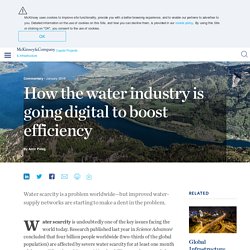
Water scarcity is undoubtedly one of the key issues facing the world today. Research published last year in Science Advances concluded that four billion people worldwide (two-thirds of the global population) are affected by severe water scarcity for at least one month of the year. What does this mean? Nearly a billion people currently have no access to clean, safe drinking water. And this shortage doesn’t only affect rural areas. Several factors contribute to a rising demand for water, including population growth, climate change, and changes in global lifestyles such as increased consumption of grain, meat, and cotton clothing, all of which have a high “water cost.” The good news is that new technologies can help utilities and cities to better manage both demand for, and supplies of, clean water. South Africa's water crisis spreads from Cape Town. The next crisis may lurk in the mountains of Lesotho, a land-locked mountain kingdom encircled by South Africa * Mountain kingdom is key water source for South Africa * Lesotho dams near historic lows, rains have been poor.
From Cape Town to Kabul: taps run dry in crisis cities. Water scarcity already affects more than 40 percent of the world's population and is expected to rise due to global warming By Umberto Bacchi LONDON, Jan 31 (Thomson Reuters Foundation) - Drought-stricken Cape Town could run out of water as soon as April, but South Africa is not alone in its struggle as ever more world cities battle acute water shortages. Water scarcity already affects more than 40 percent of the world's population and is expected to rise due to global warming, with one in four people projected to face chronic or recurring shortages by 2050, according to the United Nations. Already hosting more than half the world's people, cities are at the forefront of the problem, as population growth increases pressure on reserves, which are already stretched by too little rain and too much waste. Economist.
Sacred, life-affirming and fast disappearing: waters of the Himalayas – in pictures. In the small towns and villages of the Himalayas across India and Nepal, communities depend on surface water from glacier-fed rivers, springs, ponds and lakes for domestic use and for agriculture. Yet this is a region at the forefront of global climate change. Glaciers are shrinking quickly, particularly in the eastern and central Himalayas, which is likely to significantly reduce flows of water downstream. Intensive land uses such as logging and stone quarrying, combined with urbanisation and a rise in tourism, are all putting immense pressure on the region’s water supply. Left, steel pipelines lie stockpiled in a farmer’s field, in Kushadevi, Nepal, with a stone quarry visible behind it; right, a quarry near Dhulikhel In Dhulikhel, water demands are increasing as the town expands. Subscribe to read.
Earther. 'Limitless applications': the 'magic powder' that could prevent future crises. It sounds like a distant dystopian crisis: a world where global food and water supply chains buckle under the strain of overpopulation and climate change, before being contaminated by weapons of mass destruction unleashed in a desperate fight for access to what little is left. While the crisis may not be as unrealistic or far away as it seems, scientists are already coming up with potential solutions. Wired. These mini, man-made ‘glaciers’ are helping Himalayan farmers. High up in the Trans-Himalayan region of Ladakh, India, a local scientist named Sonam Wangchuk is creating artificial glaciers to help farmers facing the growing problem of acute water shortages. Over the past few decades, glaciers in the region (and in areas around the world) have not frozen sufficiently during the winter months, meaning there is less ice and therefore less meltwater.
Many mountain communities rely on glacial melt-water during the dry spring and summer months – including farmers in villages in Ladakh, at around 3,500m above sea level. The decline in glacial meltwater is attributed to climate change, and according to the European Geosciences Union more than 70% of glacier volume in the Everest region of the Himalayas could be lost by 2100. Wangchuk – who also teaches at the Students’ Educational and Cultural Movement of Ladakh Alternative School – initially started his project in the classroom. Image: Rolexawards.com Share. Bowl-shaped roofs harvest rainwater and promote natural cooling in arid environments. Recharging the Mountains. Nepal has always had too much rain or too little. WHAT ARE THE IMPLICATIONS OF THE FUTURE OF WATER FOR BUSINESS? – Unlocking Foresight.
Water, water, everywhere, and not a drop to drink, or should it be “not a drop to fill the coffers of business?” That is the question looming menacingly over the business horizon. Water scarcity drives food and beverage producers into action. Africa is showing itself to be one of the continents most affected by climate change, with severe droughts, floods and storms expected to increasingly threaten the health of populations and economies. The UN’s Intergovernmental Panel on Climate Change (IPCC) - the recognised global authority on climate science – has predicted that Africa will warm up to 1.5 times faster than the global average. Drought, floods and water stress cost companies $14bn. Droughts, water scarcity and stricter environmental regulations cost businesses a reported $14bn (£11bn) this year, up from $2.6bn in 2015. Yet companies still aren’t doing enough to protect themselves from water risks, according to a new report.
Wind-powered Water Seer pulls 11 gallons of clean drinking water from thin air. A new device that relies on simple condensation to collect clean water from the atmosphere promises to provide up to 11 gallons of safe drinking water without an external power source, greenhouse gas emissions, or adverse environmental impacts. Uk.businessinsider. Zero Mass. The world's threatened rivers - in pictures. Scientists accidentally create nanorods that harvest water from the air. Learning from your mistakes is a key life lesson, and it's one that researchers at Pacific Northwest National Laboratory (PNNL) can attest to.
After unintentionally creating carbon-rich nanorods, the team realized its accidental invention behaves weirdly with water, demonstrating a 20-year old theory and potentially paving the way to low-energy water harvesting systems and sweat-removing fabrics. The researchers note that ordinarily materials will absorb more water as the humidity in the air around them increases. But between 50 and 80 percent relative humidity, these nanorods will actually do the opposite and expel water, a behavior they say is not shared by any other material. Below that range, they behave as normal, so the process is reversible by lowering the humidity again. Rainwater-harvesting billboards offer lifeline to India's drought-hit farmers. On the New Airport road in the west Indian city of Pune, five Vodafone billboards are doing more to help the drought-hit village of Pimpri Sandas than the local government.
The billboards, fitted with tanks, are harvesting rainwater. Nepali Times Buzz. Salt Water into Drinking Water: World’s Largest Desalination Plant Up And Running. Baths to washing machines: welcome to the (almost) waterless home of the future. What will happen if world's biggest companies don't take water seriously? We’re running out of water, and the world’s powers are very worried. Could Harvesting Fog Help Solve the World’s Water Crisis? Over half the world’s population suffers from ‘severe’ water scarcity, scientists say. Four billion people face severe water scarcity, new research finds. Rethinking the water cycle. Groundwater is mostly non-renewable, study finds. Innovative New Greenhouse Makes It Possible To Grow Crops... Global warming drains the water of life - Climate News NetworkClimate News Network. 11.13.15 EO B 36 15. Are Resource Wars Our Future?
TU Delft: Blog 1: Cassandra’s curse. From New York to Seoul: 10 of the best designs for water-stressed cities – in pictures. Solar powered Reverse Osmosis water purification system. Why the struggle for water is a global issue. Six things business needs to know about water and sustainability. The tech industry is threatening to drink California dry. The key to water security could be lurking in a New Mexico sewage farm. Huffingtonpost. Preparing for water scarcity. A new “drinkable book” has pages that turn raw sewage into drinking water. California will soon have toughest shower head requirements in nation. 25th Anniversary series: Water stress concerns for the future. How the West Overcounts Its Water Supplies. Flood__Drought_Water21_1. Six things business needs to know about water and sustainability. New NASA data show how the world is running out of water. Global water supplies are ‘in distress’, scientists warn — FT. China and India 'water grab' dams put ecology of Himalayas in danger.
California rations water during worst droughts on record. South Asia running out of groundwater - SciDev.Net South Asia. How to Seize the Opportunities When Megatrends Collide. Titled. Water Scarcity: CDP Report Argues for Broad, Locally Relevant Strategies. 'Thirsty' Global Fracking Industry Puts Water, Environment, Communities at Risk. Graphic Novel by Patrick Sean Farley. Eight unbelievable solutions to future water shortages.
China’s Water Problems Are Even Worse Than You Think: Report - China Real Time Report. Water wars: a new reality for business and governments. The US, South Africa and Australia are turning wastewater into drinking water. Farmers Fight Coca-Cola as India’s Groundwater Dries Up. Water is the new oil: How corporations took over a basic human right. Where Will The World's Water Conflicts Erupt? [Infographic] Freshwater 101: Energy and Industry. This Tower Pulls Drinking Water Out of Thin Air. Thirsty energy: the conflict between demands for power and water. Stunning Photographs Show How We're Using And Abusing The World's Water. Arab Water Crisis to Affect Human Development Rainwater harvesting: A sustainable solution to water shortage.
China Water Pumps Market Set To Cross 85 Billion Yuan (14B) By 2018 Says TechSci Research. Drinking Water Problems. Water Pollution, Sources and Effects. Causes of Water Crisis, its Effects and How to Solve the Problem. Does Himalayan Hydro have the Power to Bring Water Co-operation? Water Scarcity. Fresh water found in ocean poses environmental concerns, difficulty to access - National Science & Space. Pakistan Has A Month's Worth Of Water Left. A Rare Middle East Agreement, on Water. Water shortage panic to replace climate change panic « England's England.
I don't agree with this, but in the interest of having both sides to the argument, have posted it here. – tricialustig
The Shower Of The Future Cuts Water Waste To Almost Nothing.